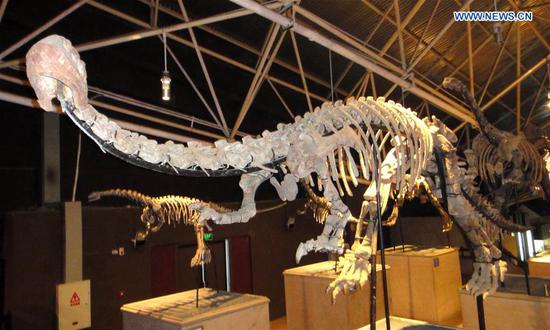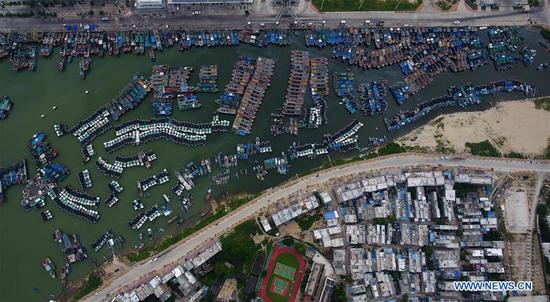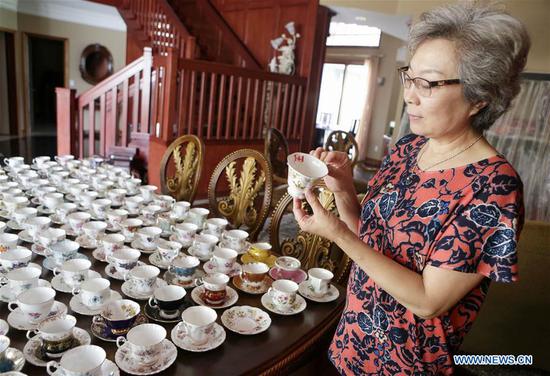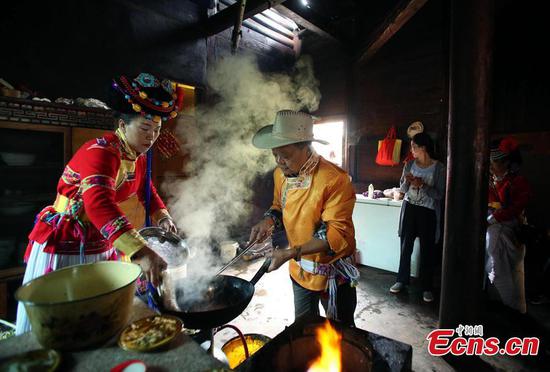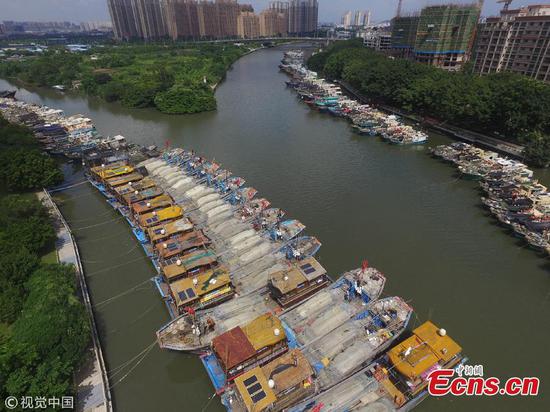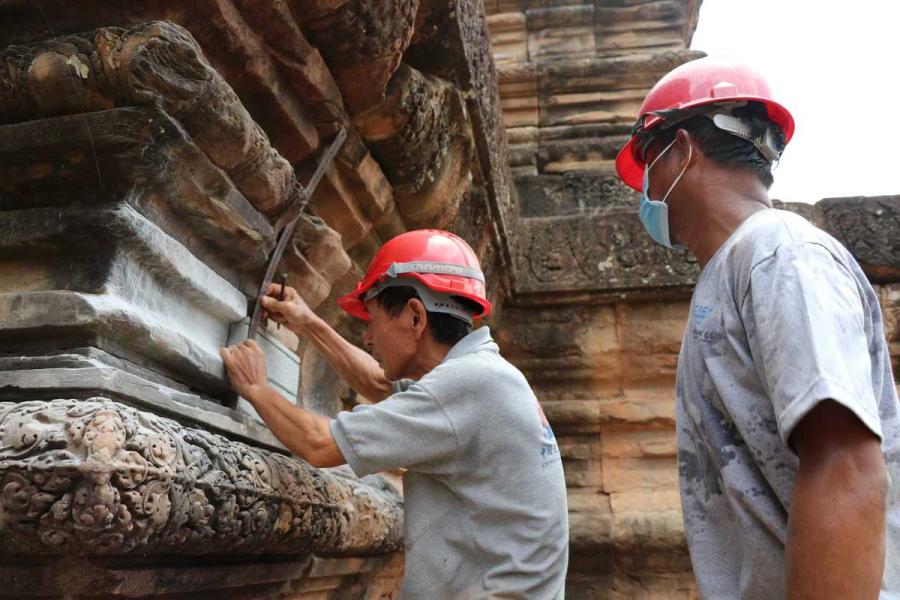
Chinese specialists help renovate Ta Keo Temple at the Angkor complex in Cambodia in July. (Photo/Xinhua)
Coordination between different countries key to success
August is probably not the best time for tourists to travel to Angkor Archaeological Park in northern Cambodia, as the rainy season brings particularly muggy conditions.
But for Yuan Mengxi, an assistant researcher at the Chinese Academy of Cultural Heritage, her trip last month was perhaps one of her most exciting, although she had been there more than 10 times.
Restoration of Ta Keo, a temple at the site built in the 10th and 11th centuries, has been completed.
"The work has been long and tough," Yuan said. "But it is meaningful when you see locals, including the elderly and children, continuing to worship deities at the shrines."
The park houses the major tourist attraction of Angkor Wat, and welcomes visitors from around the world.
But when the Angkor complex was entered onto the UNESCO World Heritage list in 1992, it was also labeled as being "in danger" due to unstable foundational architecture and severe damage caused over time by warfare.
Many parts of the temples there have collapsed, and refurbishing foundations posed potential hazards to workers.
As a result, the International Coordination Committee for the Safeguarding and Development of the Historic Site of Angkor, also known as ICC-Angkor, was organized in 1993 under the UNESCO framework. China is one of the members of this committee.
Yuan visited Ta Keo to inspect the restoration work, which the academy started in 2010.
"Maybe it's our best way to celebrate the 25th anniversary of ICC-Angkor and the 60th anniversary of the establishment of diplomatic relations between China and Cambodia," she said.
Construction of Ta Keo as a "state temple" began during the reign of Jayavarman V, a ruler during the Khmer Empire (802-1431). Covering 46,000 square meters, the site is generally considered one of the most magnificent temple-mountains in Angkor.
The term temple-mountain refers to the style for the construction of state temples during the Khmer Empire, which was influenced by Indian temple architecture.
"It's important evidence showing the transition of architectural styles from the early-stage Angkor sites with typical Hindu characters from India to the later ones featuring local Buddhism," Yuan said.
Ta Keo is also believed to be the first temple built entirely from sandstone in the Khmer Empire.
However, when the academy started restoration work, experts had to sift through tens of thousands of fallen stones and largely collapsed halls, corridors and turrets.
"We had to find the right stones in the rubble and put them back," Yuan said. "Everything has to be concise. But restoration is far more than putting the fallen stones back. The bulk of the work is done through detailed research before the engineers start."
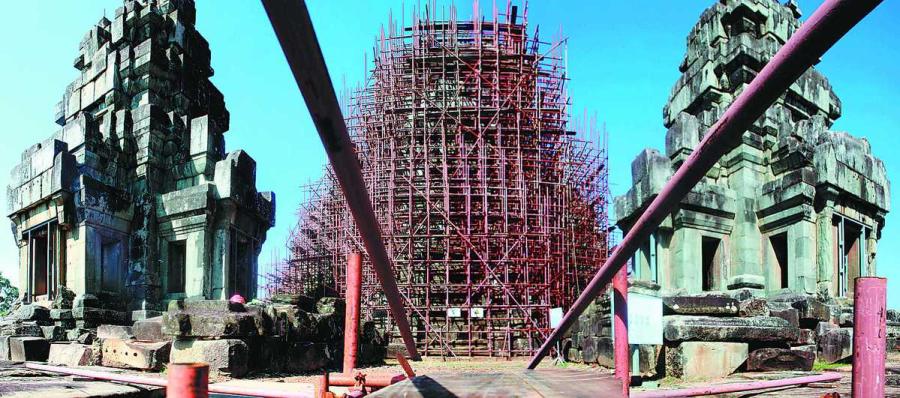
The Ta Keo Temple at the Angkor complex is being renovated by Chinese workers. (Photo/China Daily)
Step by step
Ta Keo is not the first site at the Angkor complex to be restored by Chinese.
From 1998 to 2008, the academy restored Chau Say Tevoda, a smaller temple covering 1,600 sq m. This was the first time China had been involved in international cooperation to conserve cultural heritage.
Chai Xiaoming, director of the academy, said China at that time was not experienced enough to take on a major project such as Ta Keo. ICC-Angkor was presided over by France and Japan, and both countries were given several major sites to restore, as were other Western countries such as Germany and the United States.
"It was more like an engineering project in the case of Chau Say Tevoda," Chai said. "We consolidated the construction and saved it from falling apart."
Only a small archaeological research project was carried out in this case, mainly to check whether the restored architecture was in the right position.
"Nevertheless, as our experience has grown in the past two decades, the restoration of Ta Keo became a comprehensive research program," Chai said. "It cannot be compared with fixing a house. We have to consider far more."
After detailed research, restoration of the temple was divided into 24 tailored projects, each covering a specific area of the building.
Apart from restoring the architecture, improving the environment played a crucial role, because damage caused by a poor sewage system and heavy vegetation posed safety concerns.
Ideas on the restoration of cultural relics vary among countries. Plenary sessions of ICC-Angkor were held once a year, and as any major restoration plan at the Angkor complex had to be discussed by the international committee, there was often lively debate among the different nations.
For instance, experts from other countries often tend to use chemicals to fix loose stones because such work is hard to see with the naked eye, while Chinese experts prefer to use traditional materials along with physical labor.
"It's our responsibility to tell tourists once some areas of the temple have been fixed," Chai said. "It's also important to avoid further damage being caused through using unproven methods. We have to fully elaborate our plans and make them better understood by others."
For Yuan, coordination with different countries is also an important part of their daily work. "Experts come from different countries," she said. "But they all come here to save Angkor relics. So, we often help each other."
She said all the stones needed for restoration work at the Angkor complex had to be dug from a single quarry. A shortage of labor as well as the weather conditions during the rainy season made this work more difficult.
"Then, we would borrow stones from other nations' teams," Yuan said. "The next time, they may also borrow some from us."
As France has conducted in-depth studies on the complex since the late 19th century, Chai said cross-border academic communication is indispensable.
"We cannot just shut the door and repeat research that has been done by others," he added. "It's great to have a good atmosphere in Angkor for close cooperation. French experts provided us with many valuable files."
These studies help the restoration work as well.
The construction of Ta Keo was never completed. French studies in the 1950s indicated that work was halted because the temple was hit by lightning, and the ruler considered this a bad omen. Chinese experts have respected the temple's history, leaving the uncompleted part as it was.
Many Chinese studies on sites at the complex have been carried out over the years.
In 1296, Chinese diplomat Zhou Daguan arrived in Angkor, the capital city of the Khmer Empire, and wrote The Customs of Cambodia, detailing his observations of Khmer society over a one-year period.
Now, an ongoing project by the academy aims to study Sino-Khmer relations through the evidence found at the complex that echoes observations made in Zhou's book.
Chai also expects to establish China's own systematic knowledge of Angkor studies through viewing the Buddha images, stone sculptures and other relics.
"On the one hand, we help to restore relics in Angkor," he said. "On the other hand, we are also helped greatly by being exposed to another culture."
Chinese experts who have proved their ability through their work at Ta Keo will soon have a larger stage on which to display their talent.
According to an agreement between the academy and the Cambodian management body, the Authority for the Protection and Management of Angkor and the Region of Siem Reap, commonly known as APSARA, the ruins of the Royal Palace of Angkor Thom have been opened for Chinese conservators to work at the site.
Preliminary archaeological research on the site, which covers 130,000 sq m, has been carried out by using high-tech approaches such as 3D-modeling and aerial photography by drones to prepare for the restoration.
"This large relic will mark another important step for us," said Chai, who estimates that more than 100 people from the academy have taken part in Angkor conservation programs.
Inspired by the system used to protect Angkor, a similar international joint framework was launched at Preah Vihear, another UNESCO World Heritage site in northern Cambodia, on the Thai border.
The International Coordination Committee for the Temple of Preah Vihear, which was founded in 2014, is now presided over by China and India. The academy has done some preliminary research on the site as well.
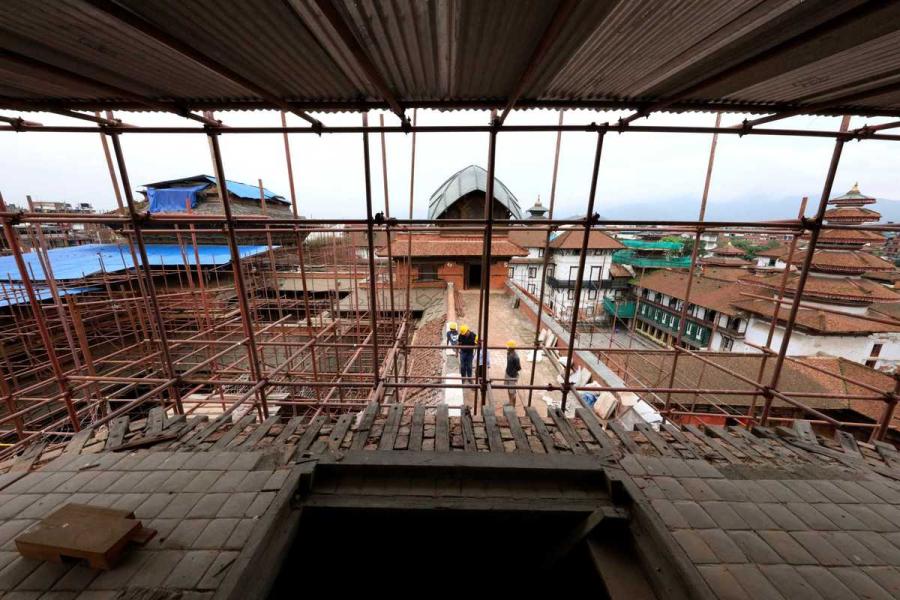
Restoration work on the nine-story Basantapur Tower in Kathmandu, the capital of Nepal, began last year and is scheduled to last for five years. (Photo/China Daily)
More projects on the way
More places in Asia are now benefiting from the academy's expertise.
On April 25, 2015, a devastating earthquake hit Nepal, leaving the World Heritage sites there in danger. According to research by the academy, 17 percent of the architecture in Kathmandu Durbar Square in the Nepalese capital collapsed or was destroyed by the quake. When UNESCO called for different countries to join hands to restore the relics, China responded quickly.
Restoration of the nine-story Basantapur Tower, which dates to 1770, began last year and is scheduled to last for five years. The site, covering 5,600 sq m, housed a former royal palace, but the tower was in ruins when Yuan arrived.
"It has heavy religious, cultural and political significance," she said. "Every step needs frequent coordination with the local authorities and rigid adherence to local culture. Still, it is a precious opportunity for us to unveil the roof of the Nepalese palace."
One courtyard in the complex was open only to Hindu pilgrims. Although experts from the academy wanted to include it in the restoration work, they decide to respect tradition and leave it untouched.
Sometimes, contradictory ideas arise, but some obstacles can be overcome through negotiation.
One beam was added in the 20th century to strengthen the palace structure. Nepalese restorers wanted to remove it to reveal the original facade, but their Chinese counterparts feared the stability of the building would be effected if it was taken out.
To resolve the situation, administrators of the relics were invited to Sichuan province in July to see how cultural heritage destroyed in the 2008 Wenchuan earthquake had been restored. "We also organized an international symposium to find the best solutions," Chai said.
As there is not enough room in Kathmandu Durbar Square for a new construction framework to be erected for the tower, this will be done at the National Museum of Nepal before being moved to the square.
"The interesting thing is our working procedure there has become a live exhibition," Yuan said. "It's good for people to know how we restore architecture."
In Uzbekistan, the ancient city of Khiva, a UNESCO World Heritage site built between the 17th and 19th centuries, is another example of the academy beginning restoration work. The Amir Tura Madrasah and Khasahmurad Mosque are among the first sites in the city being restored in the project, which began in 2016.
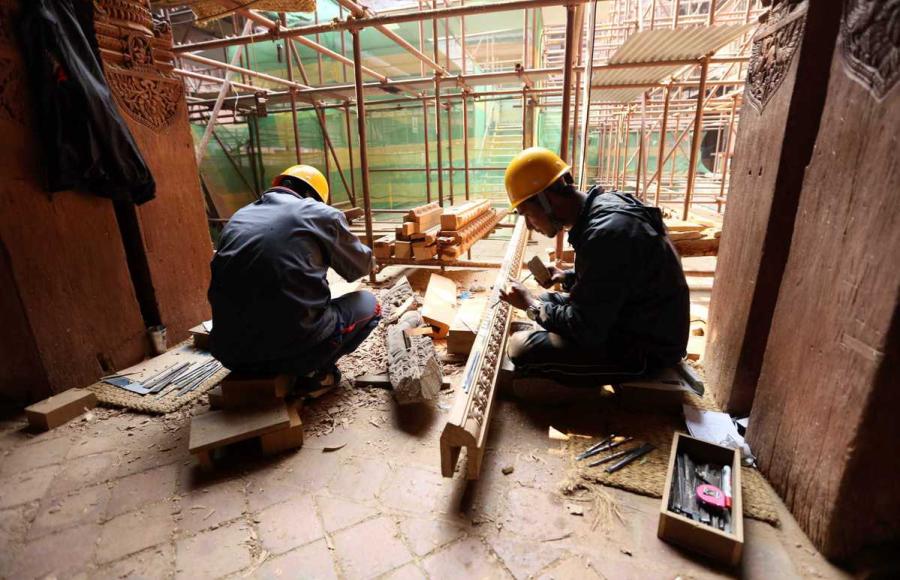
Chinese and Nepalese workers take part in restoration work at Kathmandu Durbar Square in Nepal. (Photo/China Daily)
Chain of programs
Xie Bing, director of the International Communication Department at the State Administration of Cultural Heritage, said China has conducted eight foreign aid programs for the preservation of cultural relics in six countries, and 15 joint archaeological programs in 12 countries by the end of last year.
"We've formed a relatively complete chain of programs in neighboring countries," Xie said. "These programs will strongly support cultural communication under the framework of the Belt and Road Initiative. Cultural heritage is now a crucial part of diplomacy."
Chai agrees that such programs are the best way to build ties between Chinese people and their foreign counterparts.
"It's real people-to-people connectivity, as advocated in the Belt and Road Initiative," Chai added. "And it's not necessary to win acclaim by spending huge sums of money."
For the restoration of Chau Say Tevoda, about $2 million was spent, and 40 million yuan ($5.9 million) was allocated by China's Ministry of Commerce for the Ta Keo project.
"It may be only one tenth of the money spent on building a road or bridge overseas," Chai said. "But we can win people's hearts more easily because cultural relics are close to people's emotions.
"When China builds infrastructure overseas, there are often some comments coming from the West about ideological stereotypes. However, we're not criticized, because protection of cultural heritage is a common spirit that transcends any ideological dispute."
Yuan is pleased that APSARA has given the Chinese team a three-story building as a permanent office for projects at the Angkor complex. Many academy staff members rent rooms from local residents during their long stays there.
"Completion of restoration is not the end of the job," Yuan added. "Local people's livelihoods have to be taken care of, such as the development of tourism."
The design of tourist routes has been considered in the restoration of Ta Keo. For the Basantapur Tower restoration, Yuan said efforts will also be made to improve regular exhibitions of artifacts in the palace.










